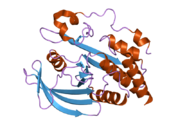Biology:PTPN3
 Generic protein structure example |
Tyrosine-protein phosphatase non-receptor type 3 is an enzyme that in humans is encoded by the PTPN3 gene.[1][2]
Function
The protein encoded by this gene is a member of the protein tyrosine phosphatase (PTP) family. PTPs are known to be signaling molecules that regulate a variety of cellular processes including cell growth, differentiation, mitotic cycle, and oncogenic transformation. This protein contains a C-terminal PTP domain and an N-terminal domain homologous to the band 4.1 superfamily of cytoskeletal-associated proteins. P97, a cell cycle regulator involved in a variety of membrane related functions, has been shown to be a substrate of this PTP. This PTP was also found to interact with, and be regulated by adaptor protein 14-3-3 beta.[2]
Interactions
PTPN3 has been shown to interact with YWHAB.[3]
References
- ↑ "Isolation of a cDNA clone encoding a human protein-tyrosine phosphatase with homology to the cytoskeletal-associated proteins band 4.1, ezrin, and talin". Proc Natl Acad Sci USA 88 (14): 5949–53. August 1991. doi:10.1073/pnas.88.14.5949. PMID 1648725. Bibcode: 1991PNAS...88.5949Y.
- ↑ 2.0 2.1 "Entrez Gene: PTPN3 protein tyrosine phosphatase, non-receptor type 3". https://www.ncbi.nlm.nih.gov/sites/entrez?Db=gene&Cmd=ShowDetailView&TermToSearch=5774.
- ↑ "Serine phosphorylation-dependent association of the band 4.1-related protein-tyrosine phosphatase PTPH1 with 14-3-3beta protein". J. Biol. Chem. 272 (43): 27281–7. October 1997. doi:10.1074/jbc.272.43.27281. PMID 9341175.
Further reading
- "cDNA cloning of new protein tyrosine phosphatases in the human colon.". Tumour Biol. 13 (3): 180–6. 1992. doi:10.1159/000217763. PMID 1626183.
- "Expression of cytoskeletal-associated protein tyrosine phosphatase PTPH1 mRNA in human hepatocellular carcinoma.". J. Gastroenterol. 29 (6): 727–32. 1995. doi:10.1007/BF02349278. PMID 7874267.
- "Expression and chromosomal assignment of PTPH1 gene encoding a cytosolic protein tyrosine phosphatase homologous to cytoskeletal-associated proteins.". Int. J. Cancer 55 (6): 947–51. 1994. doi:10.1002/ijc.2910550612. PMID 8253532.
- "Serine phosphorylation-dependent association of the band 4.1-related protein-tyrosine phosphatase PTPH1 with 14-3-3beta protein.". J. Biol. Chem. 272 (43): 27281–7. 1997. doi:10.1074/jbc.272.43.27281. PMID 9341175.
- "Identification of the cell cycle regulator VCP (p97/CDC48) as a substrate of the band 4.1-related protein-tyrosine phosphatase PTPH1.". J. Biol. Chem. 274 (25): 17806–12. 1999. doi:10.1074/jbc.274.25.17806. PMID 10364224.
- "Subcellular localization of intracellular protein tyrosine phosphatases in T cells.". Eur. J. Immunol. 30 (8): 2412–21. 2000. doi:10.1002/1521-4141(2000)30:8<2412::AID-IMMU2412>3.0.CO;2-J. PMID 10940933.
- "Evidence for regulation of the tumor necrosis factor alpha-convertase (TACE) by protein-tyrosine phosphatase PTPH1.". J. Biol. Chem. 277 (45): 42463–70. 2003. doi:10.1074/jbc.M207459200. PMID 12207026.
- "PTPH1 is a predominant protein-tyrosine phosphatase capable of interacting with and dephosphorylating the T cell receptor zeta subunit.". J. Biol. Chem. 279 (9): 7760–9. 2004. doi:10.1074/jbc.M309994200. PMID 14672952.
- "Substrate-trapping techniques in the identification of cellular PTP targets.". Methods 35 (1): 44–53. 2005. doi:10.1016/j.ymeth.2004.07.007. PMID 15588985.
- "Targeted proteomic analysis of 14-3-3 sigma, a p53 effector commonly silenced in cancer.". Mol. Cell. Proteomics 4 (6): 785–95. 2005. doi:10.1074/mcp.M500021-MCP200. PMID 15778465.
- "Cardiac sodium channel Na(v)1.5 interacts with and is regulated by the protein tyrosine phosphatase PTPH1.". Biochem. Biophys. Res. Commun. 348 (4): 1455–62. 2006. doi:10.1016/j.bbrc.2006.08.014. PMID 16930557.
- "Degradation of tyrosine phosphatase PTPN3 (PTPH1) by association with oncogenic human papillomavirus E6 proteins.". J. Virol. 81 (5): 2231–9. 2007. doi:10.1128/JVI.01979-06. PMID 17166906.
- "Protein tyrosine phosphatase H1 is a target of the E6 oncoprotein of high-risk genital human papillomaviruses.". J. Gen. Virol. 88 (Pt 11): 2956–65. 2007. doi:10.1099/vir.0.83123-0. PMID 17947517.


